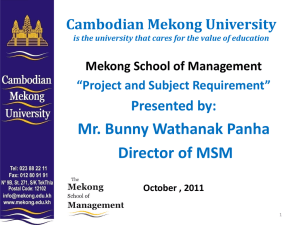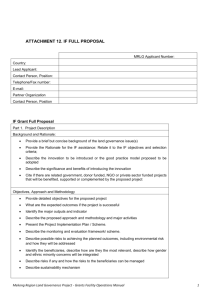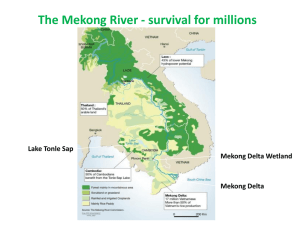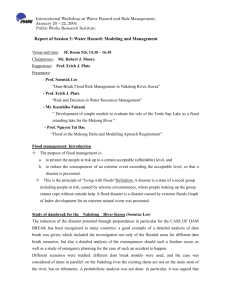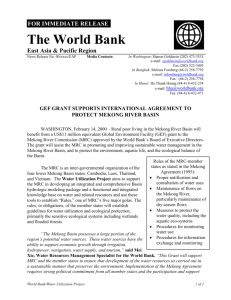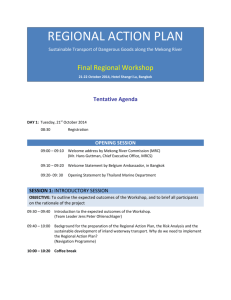ZEF Bonn
advertisement
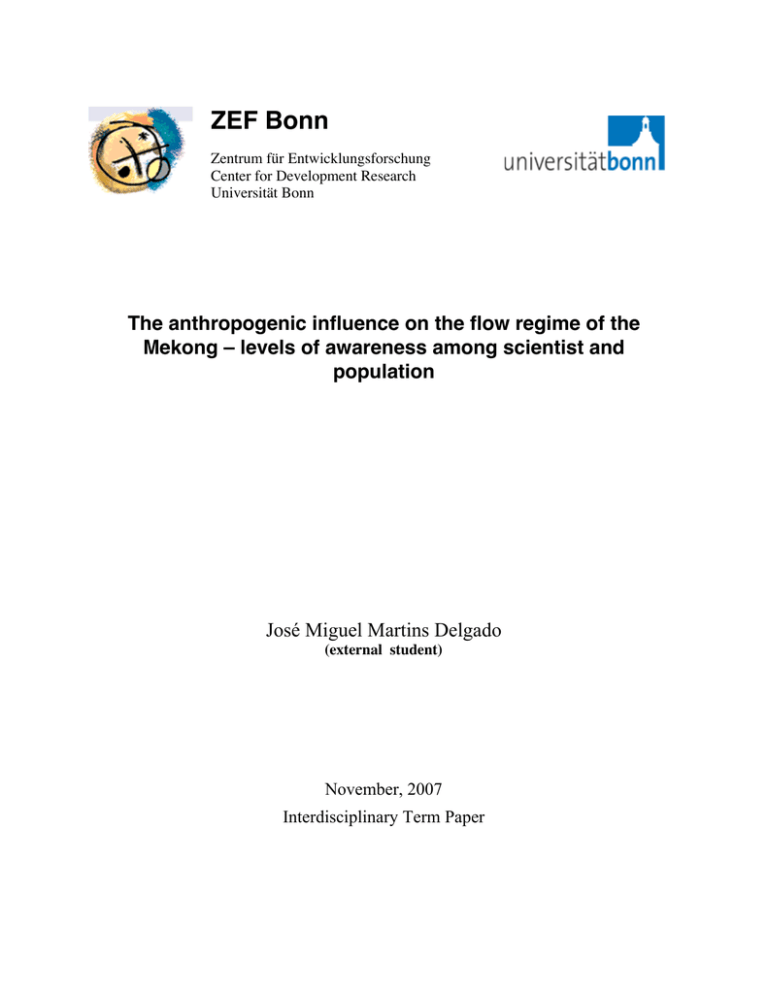
ZEF Bonn Zentrum für Entwicklungsforschung Center for Development Research Universität Bonn The anthropogenic influence on the flow regime of the Mekong – levels of awareness among scientist and population José Miguel Martins Delgado (external student) November, 2007 Interdisciplinary Term Paper 1. Introduction The flow regime of a river reflects the different scale activities of human beings. On a first approach, it is straightforward to identify them within a river basin: the construction of flood protection infrastructures, irrigation facilities, surface water withdrawal systems or dams are all actions that actively and purposely add or subtract to flow at a certain time of the hydrologic year. However, although their physical impacts are clear, the benefits that they bring to society are difficult to value. Less evident, but more controversial, are human actions within the catchment that change the flow regime as a side effect and whose primary objective is outside the sphere of hydrology. Global climate change – with its parcel of human induction – will also influence regional flow patterns to a point that is not yet fully understood. The Mekong river has its source in Tibet, more than five thousand meters above the sea level. It runs approximately half of its total length across China collecting water from what is called the upper basin. This area is only 24% of the whole basin and contributes with only 15 to 20 % of the total annual flow. The lower basin begins when the river flows into Lao PDR. Here it reaches a plateau and runs along the border between Thailand and Lao PDR. The latter is the country that most contributes to the total flow, and with the bigger potential for hydropower development. The following are Thailand and Cambodia. The three countries haven’t done anything relevant regarding irrigation, water withdrawals, hydropower or flood protection in the last 50 years. Indeed, in some places, existing infrastructure was destroyed by years of war. In addition, the long reach that makes the Thai Laotian border has been economically stagnant because of its political nature. However, with the pacification of the region, development is expected to occur on the next years (Bakker, 1999). The most productive agricultural lands in the Mekong basin are the Cambodia flood plains, the Thai Laotian plateau and, most importantly, the delta in Vietnam. The existing irrigation systems in Cambodia were disabled during the war years and haven’t yet been fully recovered. For political or economic reasons, the lower basin hasn’t been subject to economic development. According to the hopes and reasons of several authors – Elhance ( 1999), Middleton (2007), Bakker (1999), Starr (2003), Lu & Siew (2006) – we are already witnessing the dawn of an economic boom. Despite the most recent good news on the economic development of the Mekong basin, when it is compared to other major rivers of the world, one concludes that there are few studies on the Mekong basin regional climate trends or even fewer detailed hydrologic studies than in other major catchments (Hoa et al. 2007). A straight-forward search with the keyword Mekong in some of the most important scientific search engines (Science Direct, Oaister, Springer Link, Wiley Interscience, etc) yielded very poor results (approx. 3 thousand articles) when compared to other major world rivers like the Mississippi (50 thousand), the Nile (30 thousand), the Niger (30 thousand) or the Paraná (15 thousand). Despite the roughness of such an analysis, and the bias of having performed these searches based only on western publishing houses, it gives a clear overview of the amount of scientific work produced about the Mekong river. Furthermore, regarding long-term climate change, a characterization of its natural variability is not yet accomplished for the South-Western monsoon climate system (Black 2002). This does not allow yet to fully understand the anthropogenic climate change in the region, because its effects "will be super-imposed on a climatic system that also responds to natural forcing factors". The main objective of this paper is to fulfill a methodological gap in the process of understanding such phenomena. This implies identifying the past and present human activities that may permanently or periodically affect the flow regime of the Mekong river. The output of such work will feed the research for regional climatic trends and their forcing factors. The methodology is based on the review of literature about the Mekong region and other rivers around the world that presented human induced alterations of their flow regime. After identifying them, their hydrologic extent will be discussed. The consequences of this humaninduced hydrology on the livelihoods will be mentioned. Finally, the importance of the traveling stage of a scientific fact will be discussed. 2. Some methodological definitions The human activities referred to in this paper are those which potentially alter the yearly hydrograph of the Mekong river, both regarding time and magnitude. The criteria for telling whether an activity is considered potentially effectual to a natural hydrograph is difficult to define. According to the nature of the present paper, activities will be chosen if they have already effected in the natural hydrograph on the Mekong or another river and if the causal agent between the action and its effect was already shown. Activities were divided into three sets, in order to allow a clear discussion on the different levels of complexity: the first is built on those activities that purposely add, subtract, temporarily storage or prevent storaging of water within the catchment. Examples of these kinds of activities are, respectively, discharges from dams for electricity production purposes, withdrawal of water for irrigation, the operation of an artificial reservoir and a dike. The second set represents another level of complexity, because the activities it includes are not intended to effect the flow of the Mekong, although it will be seen that they do. These include agricultural and agro-forestry practices, groundwater withdrawals and fuel wood collection, all at the regional scale. Finally, the boundaries for the third set are defined by the human activities around the globe that influence the flow of the Mekong. The level of complexity reaches a maximum here, given that the scientific community suspects that there are interconnections between this regional climate system and other around the world (Black 2002). A more clear interaction is the alteration of flow seasonality in the Mekong due to climate change, reported by the IPCC (n.d.). 3. Review of literature 3.1 The first set The Mekong is one of the most natural rivers of its size (Elhance 1999). Its hydropower potential is still to operationalize, and this is being seen as a business opportunity for the next decades. Southeast Asian countries are now looking cautiously on the World Bank or the Asian Development Bank to finance their hydropower projects, now that new funders from private energy and construction companies arrive and regional government players and domestic banks are keen on support the sector (Middleton 2007) and (Bakker 1999). This previews a new wave of dam building, maybe with less strict policies towards the environment, due to the absence of domestic control (Bakker 1999). The first hydropower development plans for the Mekong were created during the 50s, mainly by the United Nations and the United States Bureau of Reclamation. However, due to armed conflict in most of the riparian states for the next 30 years, the development of any kind of major infrastructure was stagnant. The anti-dam lobbying group International River Network identifies several on-going projects: in China, the construction of two dams was completed recently, three are under construction and other three are planned; in Laos, following the country’s desire to become "the battery of Southeast Asia", about 30 dams are planned on tributaries of the Mekong and two on the main stream, although it is known that not all of these projects will have green light; finally, Cambodia also has plans to produce hydroelectricity. The impacts of the first dam to be constructed until now in the Chinese reach of Mekong, part of a project of a cascade of 8 dams, were assessed by Lu & Siew (2006). The study concluded that during the infilling period, the dry season flows showed a declining trend. More generally, after the filling of the dam, water level fluctuations increased considerably during the dry season. Lu & Siew (2006) refers that the future development of this dam cascade would reduce the frequency and magnitude of floods, therefore affecting areas which are dependent on the supply of nutrient-rich sediment that arrive with some flooding occurrences. A more thorough and transdisciplinary analysis is performed by Wyatt & Baird (2007). He collects the results of several participatory studies on the Yali Falls dam in Vietnam, on a reach of a tributary of the Mekong that flows from Vietnam to Cambodia. The dam began to be built in 1993 and since then downstream communities have been affected by unusual water level fluctuations. During the wet season, unexpected high flows, not related to rainfall, were observed. The dam also brought more water to the dry season. The communities that were most affected were settled within the Cambodian borders. Regarding irrigation, the situation is very different, when focusing different countries in the Mekong river basin. In Vietnam, for example, the most important rice production area sits totally within the basin (Elhance 1999). The Vietnamese are trying to cope with problems of different order in the delta, like salt intrusion or soil acidity, and at the same time trying to achieve three irrigated rice crops a year. This means receiving three to four thousand cumecs of water during the dry season which commonly does not happen. The solution would involve the construction of reservoirs upstream, on neighboring countries. In Cambodia, irrigated land has fallen to only 20% of the original area during war years. The damaging of the irrigation systems was one of the reasons for the productivity drop. The flood plains once made Cambodia a major rice exporter. Now, planners intend to give priority to irrigation-based food security and change the agricultural landscape dramatically. Thailand has half of its arable land within the Mekong basin, in the northeast of the country. However, water shortages in this area are impeding its development and make it the poorest part of the country, originating migrations to the capital. Laos, on its turn, is a very mountainous country, with few areas for agricultural practice, of which only a small percentage is irrigated. The upper basin has little agricultural relevance. Investment in irrigation is now a political priority, at least in Cambodia, Thailand and Vietnam (Elhance 1999). Intense activity is expected in the next years to build new irrigation infra-structure. It is clear that the implementation of irrigation systems will affect the flow regime of the Mekong, specially during the dry season. Based on a macro scale hydrologic model, Haddeland et al. (2006) concluded that the average annual reduction on flow due to irrigation was 2.3% of Mekong’s average annual runoff. However, this number is higher if the period considered is only the dry season, when the demand for irrigation is most pressing. During the last thousand years, flood protection structures have been intensively built in the Mekong delta (Cong et al. 2004). It is estimated that Vietnam has about 5700 km of dikes, although not all in the Mekong river delta. Nevertheless, it is here and in Cambodia that flood protection structures are most present. In a study by Hoa et al. (2007), the whole network of dikes and channels in the delta, so called "engineering structures", were found to increase flooding in the non-protected areas of the delta and to increase the risk of catastrophic failure of dikes. 3.2 The second set During the 90’s, the countries of the lower basin have been following the trends in the Southeast Asia deforestation. With exception of Vietnam, whose increase in primary forest area is over 2%, the forest in the lower basin has been decreasing at rates that reach 2% in Cambodia during the first five years of the third millennium (FAO 2005). However, the figures are not consensual and in WRI (2007) the variation of primary forest cover is much more pessimistic. In both cases, there is a generally negative evolution on forest cover in the region. According to Bruijnzeel (2004), who elaborated a thorough review on hydrological functions of tropical forests, this would represent an enhancement of peak flows, although not much can be said on its effects on low flows. Mcgregor & Nieuwolt (1998) is more certain about how deforestation decreases precipitation and evaporation. For the whole of the lower basin, studies were not found on the hydrologic impact of deforestation. However, a study carried out for the territory of Thailand concluded that precipitation during months with no strong external forces, like the monsoon westerlies, was decreasing locally, i. e., in the areas where deforestation activities were actually taking place. The main reason for deforestation in the Mekong lower basin is mainly fuel wood (always more than 70% of the wood product collected in each of the lower basin countries). Another important regional hydrologic driving mechanism has been identified as reforestation. The studies on this subject are also scarce (Bruijnzeel 2004), but there has been evidence of strong decreases in annual runoff after afforestation takes place, like in South Africa (Richardson & van Wilgen n. d.) with the introduction of alien species or with large scale forestation as it is occurring in China (Sun et al. 2006). Agricultural practices relate closely to irrigation. Many studies are carried out every year in order to improve water use efficiency, best management practices for more sustainable agriculture, etc. In general, there is a compromise between water and crop yield: with slight reductions in crop yield, considerable water savings are achieved either in dry climates (Vazifedoust et al. (in press)) or in rice paddy-fields (Tabbal et al. 2002). Important impacts of agro forestry practices in existing water resources were also highlighted in a public lecture by P. K. Ramachandran Nair (October 2007). Studies regarding the effect of the use of improved irrigation techniques on the lower Mekong basin were not found. 3.3 Climate Change A much discussed hydrological driving force nowadays is human induced global climate change. Whether that influences or not the regional Mekong lower basin meteorology was pointed out by IPPC (n.d.). Until now, a decrease in precipitation has been identified in southern Vietnam, which includes the delta. For the whole of the basin, the same report refers modeling exercises that simulated considerable increases in carbon dioxide emissions that resulted in non-relevant changes in annual river flows, although changes were detected in seasonality. In fact, other authors, like Anderson et al. (2002) infer that the "observed link between Eurasian snow cover and the southwest monsoon persists on a centennial scale". Anderson et al. (2002) concludes, saying that this would mean that the monsoon strength would increase over the coming century, following greenhouse gases concentration and a warmer northern Hemisphere. 4. Discussion 4.1 The problem of valuation Although it seems wrong at the first sight, it may be that the complexity of valuating human action rises when the focus is increasingly narrower. For example, is it easier to value the decision of constructing a dam or the decision of collecting fuel wood for cooking? It is very clear that the value of building a dam is far more rationalized than collecting fuel wood for cooking, although it involves a much wider background for decision making. If analyzed the other way round, one could question "what could we do in order to compensate for not building a dam/letting a peasant collect fuel wood? ". The answer is stunningly simple for the first case, involving mainly rationalization (finding other energy sources, making a well for irrigation, building flood protection) and surprisingly (or not so much) complex in the second case. When dealing with institutional and organizational decision making, complexity arises from the multiple levels of rationalization that are already functioning within the system. The human actions here discussed were previously organized according to this logic. Although all the studies invoked in section 3.1 are certainly complex, they will always be engineering issues, with technical costs and clear consequences in livelihoods. On the other hand, the activities in section 3.2 can not easily be assigned a technical or commensurable value. They imply the consideration of cultural inheritage and social networks before the implementation of laws, economic benefits or restrictions to a fundamental activity to rural communities as collecting fuel wood. The individual action of collecting fuel wood has in fact no evident impact on flow and even the collective action of deforestation has a controversial impact on hydrology. Therefore, how can ambiguous scientific results contribute to the awareness raising among local populations? It is clear that until a fact is ready to travel and reach stakeholders, it has to go through a phase of construction that does not exclude a bit of manichaeism. This bit of manichaeism, will allow the stakeholders to identify with one of the sides in dispute, which will ease the decision making. The positions taken by some scientists regarding the impact of deforestation in catchment hydrology are presently at this point of the "environment issue cycle", as pointed out by Bruijnzeel (2004): the existence of a "traditional" stance, a causeeffect chain equivocally established on one of the stages the "environment issue cycle" and the existence of several scientists that even today purposely of inadvertently ignore the existence of two opposite theories regarding the same subject testify in favor of this thesis. The same questions is raised by Tomich et al. (2004), in the third central question of the paper, "what can be done? " and more specifically "do we really know enough to act? ". The paper actually rhetorically questions if land use really harms watershed functions, considering that "millions of dollars have been spent over decades on soil conservation and watershed management projects". The point is that an environmental problem can be considered important even before it is quantified. And in general, the work done to quantify the problem is already a recognition of it. These questions are testifying the current caution of today’s policy-making when dealing with issues that involve high complexity. On the other hand, time may be lost if action is not taken in a region where the population growth rates, with the exception of Thailand, are all above 1.0% (FAO 2005). The problematic of cost of the set of all individual actions is well illustrated by the metaphor introduced by Hardin (1968). But how can unquantifiable values (like biodiversity) be introduced in the debate? They are hardly commensurable through a neoclassical economics approach1. The first level of influencing the flow regime is considered an objective level, where men decide to change the natural flow of a river, through political or economical institutions, in order to maximize an utility, say energy or water for irrigation. This would be achieved by constructing a dam, and the costs to fulfill the objective of having more energy could be communities reallocation, social chains broken, changes of most of the river related activities, loss of biodiversity and eventually carbon dioxide emissions from the decomposition of immerse organic matter. Even if some of the losses are incommensurable, the local population would be able to decide easily on the need for a dam. The construction of scientific facts is in a stage that allows them to be transferred as arguments to the different sides of the dispute. On the other hand, when talking about a side-effect level, like the second set of activities, the decision would not be so simple. The same applies to a dam, although with a lower level of complexity, because in this case, the pro- and anti- dam lobbies are all well identified (Bakker 1999). Therefore, the process of decision making is more political than technical, once the scientific facts have already finished their journeys and the decision is now more dependent on the political dynamics of both conflicting parts. In Yali Falls, for example, local communities did not even know that a dam was being built upstream their villages and they were attributing unexpected flash flooding events to "spirits", following their animist belief system. Although there are reports over these problems in many other regions of the world, the politic and economic actors ignored facts and kept building the dam. They implicitly knew the range that certain facts can reach, and they knew that a western scientific fact, as the theories of adaptation and vulnerability to flooding events, would take years to reach a local community in Cambodia. To illustrate the 1 Munda (2004) calls them social incommensurabilities. The concept is grounded on the difficulties found to operationally define value. They derive from the fact that a complex system has multiple identities. They are explained through epistemological plurality (different observers of a system) and, most importantly for this case, ontological characteristics of the observed system (non-equivalent observations). situation of asymmetry created by the imposition of a totally foreign activity in the region, the vulnerability model proposed by Vries (2007) can be discussed. Figure 1 – Vulnerability model proposed by Vies (2007) Mainly presented in a developed world context, it conceptualizes the temporal dimension in vulnerability. Most importantly to this case is that the conceptualization of the "four dwelling scales" (epistemological, cultural, social psychological and cognitive scales) fails when applied to a development context. It is easily seen that the epistemological scale is preponderant. Floods are known to local people (Hirsch & Wyatt 2004): they are kept in "memory networks" that are being eroded with time, they may be forgotten by "casual amnesia" or disbelieved at a "cognitive scale" (see figure 1), but the busilis is that they are not understood. The most static of these scales, epistemological scale is the one that increases vulnerability. Due to the complete lack of understanding of a flood phenomenon (associating it with "spirits"), the whole temporal model of vulnerability crashes. The level of knowledge asymmetry created by an input of technology was so big that the populations would not have a clue of what was going on. A flow of technology and a lack of flow of facts is adding to vulnerability. Awareness did not raise before NGOs started to add information to the local people. 5. Conclusion The human influence on the hydrology of the Mekong has been in part identified in literature, although not fully quantified. There are uncertainties on the impact of deforestation, changes in agricultural practices and of the channel and dike system on the lower Mekong basin hydrology. Regarding dams, the impacts are very well identified, although future developments of hydropower schemes have not yet been assessed. The increase of investments in irrigation has not been analyzed under the impact in the flow regime. The stage of the research on some of the issues was discussed and introduced in a concept of "environment issue cycle". The human activities where impacts are better known appear to be the ones that are politically more dynamic (dam building). The hydrological impacts of other activities, like deforestation, although accepted that exist in a considerable scale, are less understood and still raise discussion among scientific community. This poses difficulties when it is intended to raise awareness among the local population. References Anderson, D. M., Overpeck, J. T. Gupta, A. K. 2002, ‘Increase in the asian southwest monsoon during the past four centuries’, Science 297(5581). Bakker, K. 1999, ‘The politics of hydropower: developing the mekong’, Political Geography 18, 209–232. Black, D. E. 2002, ‘The rains may be a-comin”, Science 297, 528–529. Bruijnzeel, L. A. 2004, ‘Hydrological functions of the tropical forests: not seeing the soil for the trees’, Agriculture, Ecosystems and Environment (104), 185–228. Cong, T. T., Saito, Y., Huy, D. V., Nguyen, V. L., Ta, T. K. O. Tateishi, M. 2004, ‘Regimes of human and climate impacts on coastal changes in vietnam’, Regional Environmental Change 4, 49–62. de Vries, D. H. 2007, ‘Being temporal and vulnerability to natural disasters’, Studies of the University: Research, Counsel, Education - Publication Series of UNU-EHS. Elhance, A. P. 1999, Hydro-Politics in the 3rd world, United States Institute for Peace Press. FAO 2005, ‘Global forest resources assessment’, Global Tables. Haddeland, I., Lettenmaier, D. P. Skaugen, T. 2006, ‘Effects of irrigation on the water and energy balances of the colorado and mekong river basins’, Journal of Hydrology 324, 210–223. Hardin, G. 1968, ‘The tragedy of the commons’, Science 162, 1243–1248. Hirsch, P. Wyatt, A. B. 2004, ‘Negotiating local livelihoods: Scales of conflict in the se san river basin’, Asian Pacific Viewpoint 45(1), 51–68. Hoa, L. T. V., Hhan, N. H., Wolanski, E., Cong, T. T. Shigeko, H. 2007, ‘The combined impact on the flooding in vietnam’s mekong river delta of local man-made structures, sea level rise, and dams upstream in the river catchment’, Estuarine, Coastal and Shelf Science (71), 110–116. Hoanh, C. T., Guttman, H., Droogers, P. Aerts, J. 2003, Water, climate, food, and environment in the mekong basin in southeast asia, Technical report, International Water Management Institute and Mekong River Commission Secretariat and institute of Environmental Studies. IPCC n.d., ‘The regional impacts of climate change’. _http: //www.grida.no/climate/ipcc Lu, X. X. Siew, R. Y. 2006, ‘Water discharge and sediment flux changes over the past decades in the lower mekong river: possible impacts of the chinese dams’, Hydrology and Earth System Sciences 10, 181–195. McGregor, G. R. Nieuwolt, S. 1998, Tropical Climatology, John Wiley and Sons. Middleton, C. 2007, ‘New dam builders raid the mekong’, Bulletin of the International River Network. Munda, G. 2004, ‘Social multi-criteria evaluation: Methodological foundations and operational consequences’, European Journal of Operational research 158, 662–677. Richardson van Wilgenn.d.richardson: 2004 Richardson, D. M. van Wilgen, B. W. n.d., ‘Invasive alien plants in south africa: how well do we understand the ecological impacts? ’. Starr, P. 2003, ‘The people’s highway: Past, present and future on the mekong river system’, Mekong Development Series No. 3, Phnom Penh. Sun, G., Zhou, G., Zhang, Z., Wei, X., McNulty, S. G. Vose, J. M. 2006, ‘Potential water yield reduction due to forestation across china’, Journal of Hydrology 328, 548–558. Tabbal, D. F., Bouman, B. A. M., Bhuiyan, S. I., Sibayan, E. B. Sattar, M. A. 2002, ‘Onfarm strategies for reducing water in put in irrigated rice; case studies in the philippines’, Agricultural Water Management 56, 93–112. Tomich, T. P., Chomitz, K., Francisco, H., Izac, A.-M. N., Murdiyarso, D., Ratner, B. D., Thomas, D. E. van Noordwijk, M. 2004, ‘Politicy analysis and environmental problems at different scales: asking the right questions’, Agriculture, Ecosystems and Environment 104, 5–18. Vazifedoust, M., van Dam, J. C., Feddes, R. A. Feizi, M. (in press), ‘Increasing water productivity of irrigated crops under limited water supply at field scale’, Agricultural Water Management . WRI 2007, ‘Country profiles, World Resources Institute’. _http: //earthtrends.wri.org Wyatt, A. B. Baird, I. G. 2007, ‘Transboundary impact assessment in the sesan river basin: The case of the yali falls dam’, International Journal of Water Resources Development 23(3), 427–442.
